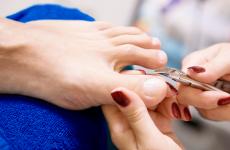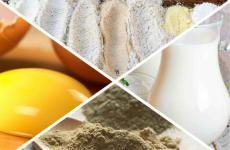Pedicure and everything you need to know about it. Pedicure: its types and frequency of use An article on the importance of doing a pedicure
I started doing manicures and pedicures on my own back in sixth grade. At the same time, I started using various facial skin creams. But if the effect of the cream is not noticeable to anyone, then well-groomed and painted nails allow you to instantly stand out from others.
Special rules for disinfecting hands and objects, as well as sterilizing instruments, have been developed for manicurists and pedicurists. According to them The pedicurist must wash her hands before working with the client and after finishing, using an antiseptic. After use, baths must be treated with a disinfectant.
The sterilization requirements for pedicurists correspond to the requirements for medical workers. But anyone who has at least visited a dentist can easily tell the difference. When cutting the cuticle, small cuts often occur, causing blood to appear. Getting it on an instrument without proper disinfection is fraught with consequences.

Why get a pedicure
In the summer - understandable. After all, toes peek out from sandals and open shoes. And you won’t be able to playfully run to the water on the beach without evidence of a serious attitude towards your appearance.
In winter, this becomes important when visiting the pool. You feel better when visiting a doctor and staying in a hospital. If a woman is married, this is a reason to please her husband. It is believed that this is done to please him, because others do not see.
But there is another reason - psychological.. Even if others are not aware, a person is constantly aware of what kind of underwear he is wearing, whether his tights or socks are torn. And are your nails in order? This involuntarily affects the manner in which one behaves, gives confidence to one’s facial expression and courage to one’s actions.
How nice it is to do yourself
Any self-care gives rise to a positive attitude, which psychologists consider a direct path to happiness. Pedicure is an art. After all, everything ends with painting - applying varnish to the nails.
Modern fashion dictates not the boring application of one color on each nail, but wild imagination. One month it is customary to alternate colors that do not match each other, the next - one nail should be slightly longer than the others. Moreover, it should shine with sparkles, which can be purchased in the store.
Keeping yourself busy wards off boredom and bad mood. No one will be able to give themselves a pedicure and be bored at the same time. A woman begins to feel better about herself, which is always reflected in her appearance. If a pedicure is done regularly and foot care is constantly taken care of, then you can do it quickly and enjoy it.
Finally, mastering any new knowledge, any of us becomes more free and independent.

Required tools and accessories
For home pedicure you will need:
- Ceramic or plastic foot bath.
- Towel.
- Heel grater.
- Fine grain pumice.
- Tweezers.
- Files of different types.
- Machine.
- Wire cutters.
- Scraper equipped with small blades for heels.
- Nail scissors.
- Softening cream.
- Finger spacers.
- Varnishes of various colors.
- Acetone and cotton swabs for correcting minor imperfections when applying varnish.
- Deodorant for feet.
Foot baths

The pedicure procedure begins with a warm bath.. It involves steaming the feet. At the same time, they soften, which facilitates further processing. You can add ingredients to the water, for example, herbs, various types of sea salt with additives, and essential oils.
Toning.
Mix sea salt, which has the property of strengthening nails, and essential oil. You can enhance the effect by adding dried mint. Proportions may vary.
Antibacterial.
Pour baking soda into the water. For a bath of water - four tablespoons. This baking soda bath is suitable for both treatment and prevention of fungal infections.. Eliminates odor.
Relaxing.
Add herbal infusion– calendula or chamomile. The infusion is prepared by pouring two tablespoons of dried plants with a glass of boiling water. It should infuse for half an hour. This composition provides a strong disinfectant effect.
Softening.
Add four tablespoons of vinegar to the water ( not to be confused with acetic acid). Apple cider vinegar will also work. The duration in this case is limited: no more than 15 minutes.
Exfoliating.
Sprinkle table salt. Place your feet in the water for a few minutes. Add two tablespoons of hydrogen peroxide to the water with salt.
After taking a bath, wipe your feet dry with a towel.

Stages
Main stages of pedicure:
- Foot baths.
- Remove any remaining nail polish applied last time using products specifically designed for nail polish remover.
- Shorten the length of your nails. Do not file them, but trim them with small tweezers.
- Soften the cuticle. Apply a softening agent to the surface of the nail and the sides.
- Treat the heels, removing rough skin from them. A special machine is driven along the surface towards the edges of the heel. Remove rough skin in thin layers, being careful not to damage the lower layers.
- Sand the surfaces of the feet with a coarse file.
- Use tweezers to treat cracks on the heels. When working, they should be placed along the crack.
- Remove dead skin on the fingertips. Use a soft file to sharpen the surface of the pads and the places where the fingers touch.
- Treat the cuticle. Wipe this area with wet wipes. Use a special spatula to move the skin from the middle to the edges.
- Finish the edge of the nail. Use a file to give it a square shape to avoid ingrowth.
- Treat the nail plates with disinfectants.
- Apply a nourishing cream to your heels to prevent cracks.
- Give a foot massage.
- Cover with varnish. Can be done in several layers. Additionally, a clear varnish can be applied on top.
Mistakes when performing a pedicure
The most common mistakes:
Do not soften your feet in too hot water. The temperature should be no more than 30 degrees. You can keep your feet in the water longer.
When removing calluses and corns, do not use scissors or a blade. This may cause cuts. To do this, use a pumice stone or a scraper.
Do not cut the corners of the nail to avoid ingrown nails. Correctly cut your nails in a straight line.
Do not use the machine to remove cuticles.
Heel treatment

There are two types of heel treatment tools. If the condition of the heel is not very advanced, using a grater is sufficient. Otherwise, machine processing is necessary.
Processing with a grater
It is better to choose a grater with a wooden rather than an iron handle. The processing surface is made of pumice, plastic, nickel, stainless steel. The rough surface is created by notches applied by a laser.
Having steamed your legs, first treat the heel with a harder coating, moving in one direction - from the sides and from the back to the middle.
Then rub the corns on the bottom of the fingers and on the side of the thumb with a grater. The leg is placed back into the bath. Take it out, dry it with a towel and treat the other leg in the same way.
Then the first one, taken out of the water and dried, is treated with the side of the grater with a softer coating, increasing the processing area. The second leg is being treated.
Processing by machine

When purchasing a machine, you need to pay attention to the material of the blade. It is better to choose surgical steel. Its advantage is increased wear resistance. Blades are included with the machine.
The preparatory step is steaming the legs with the addition of the desired components. Then you need to wipe your feet dry. Using light movements, without creating excessive pressure, begin to treat the foot, paying attention to the roughest areas. Direction: from the edges to the center of the heel.
The final stage will be to re-immerse the feet in the bath, and then treat the skin with a sanding file. Finally, apply the cream.
Cuticle treatment
The function of the cuticle is defense. The base of the nail is protected from infections entering this area. When doing a pedicure, the goal is to get rid of dead cuticle cells. As the cuticle grows, it dries out, causing hangnails to appear. Nails grow more slowly and their appearance deteriorates. Only constant care for the condition of the cuticle will make it healthy and give it a well-groomed appearance.
Trimming method

A method when the cuticle is trimmed with scissors or tweezers. Preference is given to tweezers made of hand-sharpened high-quality stainless steel.
Steam your feet in the bath. Remove one foot and dry it with a towel. Apply a product that has a softening effect to your nails in the cuticle area. Keep it on your nails for a little while. Take a damp cloth and remove any remaining product.
Take a spatula from the pedicure set and begin to carefully push back the cuticle, moving from the edge of the nail to its middle. Then take out a tool with a sharp end from the set and go through it, cleaning the skin of the thin layer that grows on the nail. Perform carefully without scratching the nail.
Take the tweezers and trim the skin around the nail. Trim your cuticles one at a time to prevent hangnails. Lubricate the cuticle area with the oil intended for this purpose. Treat the second foot.
Unedged method
With this method keratolics are used instead of tweezers. When applied, the cuticle softens. Then she moves away with the help of an orange stick. Then you need to apply a cuticle remover. After some time, the cuticle is pushed back again. The pedicure ends with cuticle oil treatment.

The advantage of this processing method is safety. With this method, only dead skin areas are removed, while the living ones remain as protection against bacterial infection.
Hardware method
Unlike classical, hardware - does not require steaming your feet. A special oil is used to soften. The product acts selectively only on keratinized and dead skin. Living areas are not affected. Provides healing and disinfection effect.
Processing is carried out using grinding attachments and machine cutters. There is no cutting of the cuticle. It is impossible for an injury to occur.
The kit includes nozzles of various diameters. Nozzles of large diameters are used when there is a need to treat the feet, especially the heels. Small nozzles with a semicircular shape are used when the areas between adjacent fingers and the skin near the nail are treated.
The design consists of a device and a handle on which attachments are attached. First, the legs are treated with a coarse nozzle. Then, with a large amount of dead skin removed, they are replaced with more delicate ones. There are attachments designed for different areas of the foot. Nails, cuticles, periungual skin, calluses, and heel cracks are subject to care.

Stages of implementation
- Apply softening cream for about fifteen minutes.
- Remove dead and rough skin using attachments.
- Using cutters, remove corns and treat calluses.
- Sand the cuticles.
- Using a nail file, give them the desired shape.
- Polish.
- Sanding to achieve final gloss.
- Apply emollient cream.
- Massage your feet.
- Apply varnish.
The technology for performing hardware pedicure is clearly shown in the video below:
Treatment of calluses
The pedicure apparatus includes callus removal attachment. It removes calluses delicately without damaging the skin. A cream is placed in the remaining hole, which removes the roots of the callus being treated.
Circulation
During treatment, the device constantly massages. As a result, blood circulation improves, which has a beneficial effect on the skin of the foot.
After a pedicure performed using a hardware method, the skin that was removed does not begin to grow as quickly as when the pedicure was performed using a trimming method. The skin retains its elasticity for a longer time and becomes much less rough.
Applying cream
A pedicure performed at home should be completed with the use of a cream that has the property of softening the skin. If the skin of the feet is very rough, there is an option when the cream is applied at night and socks are put on the feet.
Massage
Massage improves blood circulation in the legs. If your feet are dry, you can use nourishing creams. If you sweat profusely, you should use a product with a deodorizing effect. If your legs are tired at the end of the day, it is advisable to use a cream with a tonic effect. Any vegetable oil can be used.
Applying varnish

When applying varnish Convenient to use finger separators. This will protect you from accidentally getting varnish on an adjacent nail, especially if they were supposed to have different colors.
Before you paint your nails, you need to degrease with an acetone-free product. A special base must be applied under the varnish. The varnish is applied in two layers with a special brush. The procedure is completed by applying a fixative.
Pedicure maintenance and care
Do not forget Apply oil to your nails daily. With proper care, it will become noticeable that the cuticle becomes more elastic and begins to fit much more tightly to the nail. Nail growth becomes faster, its surface becomes smoother.
Conclusion
Get pedicures regularly- a useful and pleasant habit. Doing it yourself is not at all difficult. This saves time and money. The effect will be noticeable within a short time.
When a beautiful lady wears elegant shoes, but her toenails are sloppy and calluses are visible... Is this beautiful? And the shoes won't save you. Therefore, it is worth understanding that pedicure is a mandatory procedure for women. It must be done without fail. Beautiful and well-groomed legs give us strength and a good mood. And then the question comes: how often should you do a pedicure?
In fact, how often you should get a pedicure is a controversial issue. After all, everything depends on the technique of performing the procedure itself. For example, after a mechanical pedicure, your feet remain in good condition longer than after a classic pedicure. Therefore, it is worth clarifying all the nuances first before answering this question.
How often do you get a pedicure?
The frequency of the procedure depends on the woman's skin type. For example, in the summer it is recommended to do a pedicure once every 2 weeks. Indeed, during this period, a woman wears open shoes and her legs are subject to greater trials than usual. In summer, more careful self-care is necessary.
Among other things, frequent pedicures are necessary for ingrown toenails. It is very painful and requires constant care. You may need to contact your doctor. Usually, soft flagella can be inserted under the nail plate. They will straighten the nail. If you do pedicures more often, you will be able to avoid such problems in the future.
To prevent such problems, it is recommended to have a hardware pedicure once a week. After just three sessions, your skin will look completely different. Soft grinding does not injure the skin at all. Moreover, the session will only take 20 minutes maximum. Pedicure is carried out without steaming.
If you have problems with your legs, you will need to make a lot of effort to improve their condition. And therefore you will have to do pedicures more often. The specialist with whom you are doing the procedure will be able to advise on creams and preparations that will need to be applied at home after the pedicure. And within a week after the pedicure, you need to do therapeutic compresses.
With regular pedicures and foot care, there should be no problems with sleeping feet. But if there is still no improvement, then it’s time to consult an endocrinologist; perhaps the matter is completely different and the problem lies much deeper.
You don't have to have a professional pedicure to have beautiful legs. This is also possible at home, but it is worth noting that this type of pedicure will have to be done more often than in a salon. After all, not everyone is able to clean their skin well. For dry and thin skin, it is enough to do pedicures every three weeks. Don't get too carried away with polishing, as this can damage the skin. And then she will become rude even faster.
Before each pedicure, disinfect all your tools. The ions should be yours only, so as not to infect yourself. Don't lend them to your girlfriends. It's not hygienic.
Every woman should know that it is necessary to take care of her legs every day. Then you can achieve perfect results. Of course, if you get a pedicure once a month, it won’t do any good. Foot care should become a habit. Every evening you need to smear your feet with a softening or healing cream. Many people recommend snake oil cream. This is an excellent prevention against fungal diseases and corns.
Well-groomed legs in open shoes are so beautiful! Our heels require no less attention and care than our face, body and hands. And don’t think that a pedicure is just timely painted nails.
If you pamper your feet with regular pedicures and massages, then you probably know that thanks to these seemingly little things, your mood improves, your walk becomes easier, and you don’t feel tired for much longer. So why not make foot care a routine, just like showering, brushing your teeth or cleansing your face? At the same time, you can take care in different ways: eliminate minor deficiencies yourself at home, or carry out hygienic and therapeutic procedures in a pedicure office.
Types of pedicure
Pedicure is special care for the feet and toes with cleaning, polishing and correction of nails, removing rough skin, corns and calluses. Today, salons perform classic trimmed, European untrimmed, hardware, combined and SPA pedicures. Classic edged. The feet are steamed in warm water and processed using graters, pumice, a special blade, and the cuticle is cut using scissors and tweezers.
European unedged. The only difference from the classic version is that the cuticle is not cut, but only softened with a special cream and then pushed back with a wooden stick. With each subsequent procedure, the skin becomes thinner.
European dry unedged . The peculiarity of this method of care is that the legs are not steamed and the master does not use metal tools. Corns and rough skin are locally treated with emollient compounds, which facilitates their layer-by-layer removal. This pedicure is hygienic and eliminates the risk of infection with fungus or other infections through microcracks and wounds.
Mixed (combined). This is the same classic pedicure with steaming the feet in a bath and cutting the cuticle, only the heels are polished and the calluses are removed using hardware on a wet foot, which, however, can after a while lead to the formation of peeling and cracks on the heels.
Hardware. To carry out the procedure, a special apparatus with grinding attachments is used to treat the surface of the nail and skin of the foot without prior soaking. Of course, the device itself looks like a drill, but it’s not at all that scary! The main thing is to correctly calculate the exposure time and the number of rotations of the nozzles, so as not to injure the nail plate and sole.
An experienced master will select such a rotation speed that you will not experience any pain (except for a slight tickling). Just keep in mind: the procedure involves several stages and lasts from one and a half to two hours. But you won’t find it too tiring - you will spend time in a comfortable orthopedic chair, in which you can even sleep a little if you wish.
In addition to skin care itself, a hardware pedicure will cope with dry calluses (cutting them off yourself is fraught with the most unpleasant consequences). The master will remove them entirely, along with the root, painlessly and safely. Hardware pedicure is not only effective, but also useful, since during grinding there is acupressure of all reflex zones of the foot.
If you haven’t paid enough attention to foot care in winter, you’ll probably have to go to the salon twice a month at first. But soon you will feel that you need professional intervention less and less often and you can keep your legs in perfect condition by visiting a specialist once every month and a half.
SPA- A pedicure can give you a real sea of pleasure. In two to three hours you will receive comprehensive care, including nail straightening, foot massage and paraffin therapy, as well as treatment of calluses and corns using modern cosmetics based on natural ingredients: various peelings). A scrub consists of a base (usually a cream, gel, cosmetic clay) and abrasive particles (natural or synthetic).">scrubs, masks, lotions and oils. This is not only a hygienic procedure, but also a real treatment. The effect of SPA pedicure is so effective that a repeat session is usually required no earlier than a month later.
Today, salons also offer a pleasant new product – chocolate foot wraps. At the end of the pedicure procedure, your feet are immersed in a special chocolate paste, which makes the skin incredibly soft and silky.
Calluses and cracks
Quite common problems are dryness and keratinization of the skin of the heels, the appearance of cracks or abrasions. Daily foot baths will significantly improve the condition of your feet. They not only cleanse the skin, but also increase blood circulation. You can stir baking soda in water (a tablespoon per liter of water) or chamomile infusion (three tablespoons per liter of water).With a significant thickening of the stratum corneum (usually on the soles), painful yellowish growths form - calluses and calluses. It is recommended to treat them in a pedicure salon. At home, you can make a poultice from the leaves of common ivy, which are applied to the lesions. A good result is obtained by lubricating calluses with fresh juice from the leaves of sundew, as well as foot baths from decoctions of coltsfoot leaves and white willow bark.
To avoid infection of wounds due to abrasions, it is advisable to add a decoction of oak bark, nettle or plantain leaves (two tablespoons of raw materials per liter of water) and a crystal of potassium permanganate (pink solution) to the water. They have tanning and disinfecting properties. After the bath, your feet should be wiped dry, lubricated with cream and given a light massage. If cracked heels, despite the measures taken, do not heal for a long time, you need to consult a dermatologist. After all, they can serve as a gateway for fungal infection.
Maintenance pedicure procedures
Traditionally problem areas are the heel, big toe, little toe and the balls of the toes. It is here that the most painful corns and calluses from hardened skin settle and “register”, causing a lot of unpleasant sensations. After all, shoes put pressure on our poor toes, and even the narrowest straps can cause serious injury. It is very important not to start the process of callus formation and to constantly care for difficult areas, maintaining the smoothness and softness of the skin.Your main helpers are softening and moisturizing creams. In summer, it is best to opt for those products that contain extracts of medicinal herbs. At least twice a week you need to exfoliate your feet. A scrub consists of a base (usually a cream, gel, cosmetic clay) and abrasive particles (natural or synthetic). A scrub with exfoliating components and particles of natural products: crushed almond, apricot, grape seeds, etc. But you should not use peeling intended for the body - you will not achieve the desired effect.
By the way, about peeling. A scrub consists of a base (usually a cream, gel, cosmetic clay) and abrasive particles (natural or synthetic). skin, then rinse first with hot and then cool water.
Evening pedicure session
Tired, buzzing feet in the evening can be soothed and refreshed with baths that will also be beneficial for the skin. Add six drops each of eucalyptus and rosemary oil to hot water and soak your feet in it for about ten minutes. Then put it under a contrast shower to improve blood circulation.If the skin is inflamed and flaky, it is good to make a bath of rolled oatmeal infusion. To do this, pour 150 grams of flakes with a glass of boiling water, add the mixture to warm water, add to the desired volume and soak your feet in it for 15–20 minutes. A 15-minute hot bath with the addition of three to four tablespoons of honey also perfectly softens the skin. Blue clay, which is sold in pharmacies, is ideal for preventing cracks. Dilute it to the consistency of sour cream, apply it to your feet, let it dry, and then rinse with warm water.
If you nevertheless decide to remove the callus yourself, after the procedure, be sure to cover the intervention site with a special bactericidal pad, otherwise there is a risk of infection and further injuring the area. Another nuisance is blisters from rubbing with shoes. Anti-sweat disinfectants will help you avoid this scourge. Today there are a huge number of them on sale: talcs, sprays, deodorants with any fragrance - from a light floral scent to the aroma of a sea breeze. And if a water callus does appear, to eliminate the burning sensation and pain, wipe it with a piece of cotton wool soaked in cold milk.
NAIL ART in pedicure!
Summer is the best time when you can allow yourself to get creative and use nail designs to decorate your toenails in different ways. In this case, many things will be appropriate: extensions, decoration with multi-colored rhinestones, gluing applications, French pedicure, nail art with decorative painting, ornaments or plot pictures. It all depends on the skill of the nail designer, your taste and shoes. After all, you don’t want to hide such beauty in closed shoes!Modern trends are far from strict rules. Today, foot polish does not have to match the color of your lipstick and manicure. Today's classic is a polish several shades darker than on the hands. Young girls prefer lilac, pink, crimson shades, older women prefer beige, burgundy, colorless, sometimes with light pearl or sparkles.
It’s especially chic when the polish has the same color (and even pattern) as the sandals. One problem is that you most likely have so many summer shoes that you will have to repaint your toenails every day. But this won’t scare a real fashionista.
Expert opinion:
Lamunina Marina , master of manicure and pedicure at the Zhenes Regeneration Center
“The most optimal pedicure method is determined by the master after studying the condition of the client’s feet. We recommend repeating the traditional pedicure procedure on average once every two weeks; if you have not done it before, you will have to resort to hardware care more often at first. However, after six to eight procedures, you will notice that you need pedicures less often. And, of course, special foot care should be included in the mandatory list of procedures before any important events in your life, especially if the outfit involves open shoes.”
Hello, friends, Lena Zhabinskaya is with you!
Every woman dreams of soft heels, well-groomed nails and healthy skin on her feet.
For their sake, she is ready to buy dozens of jars with all kinds of scrubs, creams and masks, applying them daily, or visit expensive salon treatments every week, which, by the way, in some cases can harm our health in the form of cuts and infections.
But is this necessary? Today we will talk about how often you can do a pedicure, which types are best to give preference at home or in the salon and why, and how to significantly simplify the procedure for doing it. So sit back, let's get started.
How often do you get a pedicure?
Perhaps in our country the answer will be obvious: “regularly, in the summer.”
This means that with the average girl/woman weighing 55–65 kg, two small feet 24–28 cm long, which are responsible for our balance, do not receive the care they need for almost 7 months a year.
As a result, the skin on them becomes rougher, does not allow the remaining cells to “breathe” and renew themselves, and at some point it simply cracks.
The only way to avoid this is by regularly walking barefoot down the street, which is simply unacceptable in the city, or by getting a pedicure.
How often should you take care of your feet?
It is difficult to answer this question unambiguously, because it all depends on the lifestyle of their owner, the time of year (in summer, the legs are exposed to heavy loads due to open shoes) and the type of pedicure.
However, according to the masters, you need to focus on their appearance. As soon as it leaves much to be desired, you should take up the file and do a pedicure at home or go to professionals. It also makes sense to find out which of the two types of women you belong to, because each has its own schedule.
So, today you can find:

These are those representatives of the fair half of humanity whose shelves are literally littered with cosmetics, including those for the feet.
By actively using it, they can afford to have a pedicure in a salon once every 3-4 weeks.
Just to refresh your gel polish;
- active ladies.
Every day is scheduled down to the minute. They barely have time to eat and sleep and most often have no time for proper home foot care.
But is this worth getting upset about? It’s unlikely that it’s enough to just visit a specialist once every one and a half to two weeks, performing a pedicure and covering your nails with biogel or your favorite gel polish.
Does the frequency of pedicure depend on its type?
You can figure this out only by studying the intricacies of each procedure:
- Classic edged.
It comes down to removing corns and keratinized epidermis, as well as caring for nails. Many women successfully do it at home as needed, and there is nothing wrong with that.
It’s worse when they go to untested craftsmen in salons, where they can get fungus, because water is a favorable environment for its proliferation, or leave cuts, which are a breeding ground for skin infection, or use untreated instruments.
In addition, due to steaming and cutting off the rough skin, its growth can only intensify, provoking new corns to replace the old ones, and so on in a circle. Is there a way out? Yes, and its name is hardware or acid pedicure.

His motto: “No water - no fungus, no tools - no cuts and injuries.”
In fact, all this is perfectly illustrated.
That is why masters advise giving preference to this type of pedicure more often, especially since it copes well with the most advanced cases, without affecting the speed of regeneration of cut tissues.
- Acidic or creamy.
Despite the scary name, it is incredibly simple to do. A special cream containing glycolic and fruit acids is applied to the skin of the foot, and after some time it is removed along with particles of rough skin.
The advantage of this procedure is its simplicity and the peeling effect it provides, while the disadvantages are the presence of contraindications to it.
However, you can always take lactic acid instead of fruit acid, if there are no unhealed wounds, and enjoy amazing results.
How often do you do a pedicure at home and in what way? Write in the comments!
For a modern girl and woman, a pedicure is not a luxury, but a necessity. Therefore, pamper your feet with it more often and be irresistible!
Lena Zhabinskaya was with you, bye-bye!
The question is very broad - it all depends on the condition of the legs, the presence or absence of special problems, fashion, and personal preferences.
What matters is the time of year, the technique of performing the procedure and the level of skill of the person performing it.
Pedicure should not only be understood as decorating nails with varnish and giving them the desired length and shape, and not just hygienic treatment of the feet.
Such things are done at will, as well as regularly in the bath or shower. Pedicure is a comprehensive treatment of nails and skin of the feet, aimed at cleansing and healing them.
On our website it will not be difficult to find a specialist or salon where they will professionally treat feet even with the most serious problems and tell you how to properly do a pedicure yourself.
We publish information about the masters with questionnaires and reviews of their work, which will help you make the right choice.
Features of a proper pedicure
The answer to the question of how to do it correctly depends on which method is chosen. Japanese pedicure does not accept the use of metal tools and chemical care products.
In a classic trim pedicure, on the contrary, metal scissors and tweezers are used. Hardware pedicure is done only on dry skin, and classic or unedged pedicure requires mandatory steaming.
The master knows how to do a pedicure depending on the wishes of the client and the condition of her feet, and will be able to advise the optimal method in this case.
How often to get a pedicure
The correct solution to the problem of how often to do a pedicure. Depends on the time of year and the chosen method of performing the procedure.
In summer, the skin on your feet becomes more dry and more dirty due to wearing open shoes. Therefore, the procedure must be carried out more often than in winter. A hardware pedicure provides a more lasting effect than a manual one, so in this case you will have to contact a specialist less often.

On average, it is believed that in summer it is better to do a manual pedicure once every 2 weeks, and a hardware pedicure every 3 weeks. In the cold season, this period increases to 3 and 4 weeks, respectively. In the intervals between visits to the salon, you need to trim your nails yourself with a file and treat the skin of your feet with pumice and nourishing creams.
The frequency of pedicure procedures may change due to the presence of special problems - calluses, thickened skin, ingrown nails. In this case, the frequency of visits is set by the wizard. Sometimes such problems even have to be resolved through a doctor.
The question of how often to do a decorative pedicure depends on the chosen product. A pedicure with shellac can easily last more than 2 weeks, and with regular varnish - on average a week.
And most importantly, pedicures just need to be done regularly, carefully and competently.





